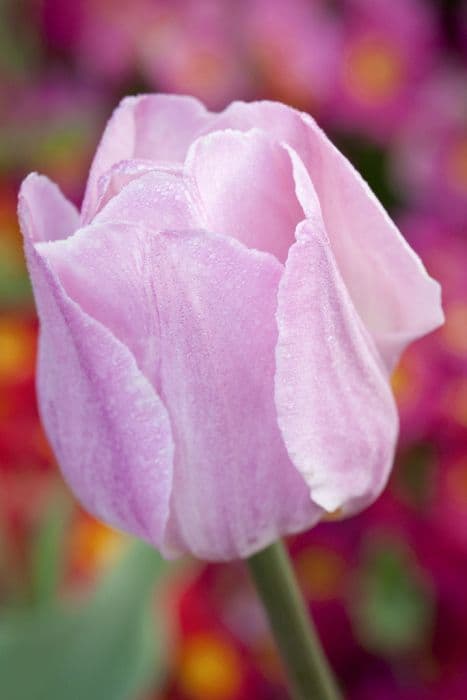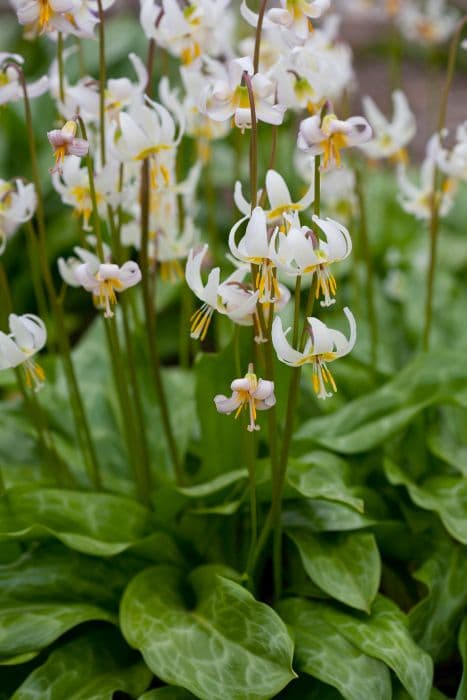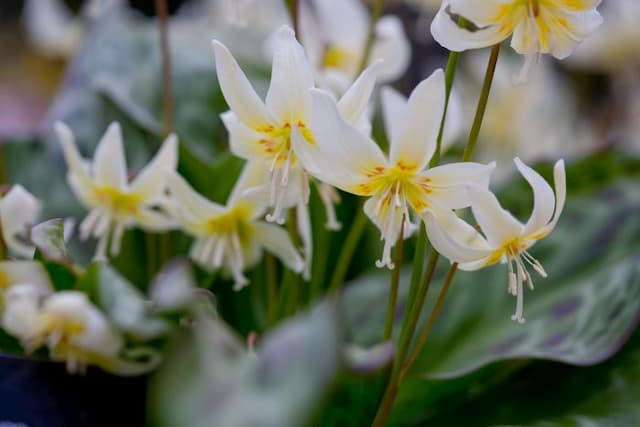Tulip Tulipa 'Rosalie' (3)

ABOUT
Tulipa 'Rosalie', commonly known as the Rosalie tulip, is a flowering bulb plant that is recognized by its striking blooms. The flowers of the Rosalie tulip are cup-shaped with a graceful form and display a beautiful blend of colors. Their petals have a soft, transition from a creamy base color which gradually intensifies to a vivid, rosy-pink shade at the tips and the edges. The inside of the blooms can reveal a pop of yellow at the base, accompanied by a mottled effect which adds depth and intricacy to the flower's appearance. The petals are slightly pointed and may exhibit a gentle curl, contributing to the plant's elegant and ornamental presence in gardens and arrangements. The foliage of the Rosalie tulip is also attractive, with long, lance-shaped, green leaves that sometimes have a glaucous or blue-green sheen. These leaves typically grow at the base of the plant, forming a tidy clump. The plant produces these exquisite flowers in the spring, making it a cherished addition to seasonal displays. It can contribute to a lovely pastel theme in a garden when planted in groups or used as a delicate accent among other spring flowers. The blossoms of the Rosalie tulip can also attract variety of pollinators, adding to the vibrancy of its surroundings.
About this plant
 Names
NamesFamily
Liliaceae
Synonyms
Rosalie Tulip
Common names
Tulipa 'Rosalie'
 Toxicity
ToxicityTo humans
Tulip 'Rosalie' is generally not considered highly toxic to humans. However, all parts of the tulip plant contain compounds that can be irritating to the skin and digestive system if ingested. The bulb, in particular, contains glycosides and alkaloids that can cause symptoms if consumed in large quantities. Symptoms of tulip poisoning may include nausea, vomiting, diarrhea, and abdominal pain. In rare cases, ingestion may lead to more severe reactions, but this is generally uncommon. It is always advised to keep tulip bulbs and plants out of reach of small children who might accidentally ingest them.
To pets
Tulip 'Rosalie' can be toxic to pets if ingested, particularly the bulbs. Tulips contain allergenic lactones and other compounds that can irritate pets' tissues. If a pet, such as a dog or cat, eats tulip bulbs, it may experience symptoms like gastrointestinal irritation, drooling, loss of appetite, a change in heart rate, convulsions, and depression. These symptoms can arise due to the presence of tulipalin A and tulipalin B in the plant material. If you suspect your pet has ingested tulip bulbs, it is important to seek veterinary attention promptly.
 Characteristics
CharacteristicsLife cycle
Perennials
Foliage type
Deciduous
Color of leaves
Green
Flower color
Pink
Height
1-2 feet (30-60 cm)
Spread
3-6 inches (7-15 cm)
Plant type
Bulb
Hardiness zones
3-8
Native area
Central Asia
Benefits
 General Benefits
General Benefits- Attractive Blooms: Tulipa 'Rosalie' features stunning flowers that add aesthetic value to gardens and landscapes.
- Easy to Grow: This tulip variety is known for being easy to cultivate, suitable for gardeners of all skill levels.
- Spring Interest: Blooming in the spring, it provides seasonal interest after winter, rejuvenating garden spaces.
- Versatile Planting: Can be planted in flower beds, borders, and containers, offering flexibility in garden design.
- Pollinator Friendly: Attracts bees and other pollinators, supporting local ecosystems and biodiversity.
- Low Maintenance: Requires minimal care beyond initial planting and occasional watering and feeding.
- Cut Flower Use: The blooms are excellent for cutting and using in floral arrangements indoors.
 Medical Properties
Medical PropertiesThis plant is not used for medical purposes.
 Air-purifying Qualities
Air-purifying QualitiesThis plant is not specifically known for air purifying qualities.
 Other Uses
Other Uses- The petals of Tulips can be used to create a natural dye for fabrics, providing a range of colors from pink to green depending on the mordant used.
- Tulip petals, particularly of the 'Rosalie' variety, can be crystallized and used as an edible decoration on desserts and cakes.
- The sturdy stems of Tulips can be used in crafting activities, such as making homemade paper or as support in small floral arrangements.
- When dried, Tulip petals can be incorporated into potpourri mixes for a subtly floral fragrance in the home.
- Tulip bulbs can be used as a replacement for onions in cooking in times of scarcity, although they have a very different taste and must be prepared properly to avoid toxicity.
- The unique shape of Tulip flowers can serve as inspiration for artists and designers, influencing patterns in textiles, wallpapers, and other decorative arts.
- Gardeners sometimes use crushed Tulip petals as a natural colorant to mark lines or patterns when designing garden layouts.
- Tulip blooms can be hollowed out and creatively used as tiny biodegradable vases for holding other small flowers or decorative elements.
- Dried Tulip petals can be used in crafting eco-friendly confetti for celebrations, providing a biodegradable alternative to plastic confetti.
- The flower shape of Tulips is emulated in certain architectural elements, such as lamp designs or fountain sprouts, bringing a touch of nature's design into urban environments.
Interesting Facts
 Feng Shui
Feng ShuiThe Tulip is not typically discussed in traditional Feng Shui practice.
 Zodiac Sign Compitability
Zodiac Sign CompitabilityThe Tulip is not used in astrology practice.
 Plant Symbolism
Plant Symbolism- Perfect Love: The Tulip, often associated with deep, unconditional love, is symbolic of the eternal nature of love. 'Rosalie' Tulips, with their beautiful form and color, evoke this timeless sentiment.
- Renewal and Rebirth: Like many tulips that bloom in the spring, 'Rosalie' Tulips are seen as heralds of renewal and the rebirth that comes with the changing seasons, representing new beginnings and fresh starts.
- Forgiveness: Tulips can sometimes represent forgiveness, offering a way to express regret and a desire for reconciliation. 'Rosalie' Tulips, by extension, carry this symbol of healing and mending relationships.
- Charity: The Tulip's generous bloom is sometimes connected with the idea of charity and giving. 'Rosalie' Tulips, in their full bloom, can represent the bloom of generosity and compassion towards others.
- Royalty: Given their history and status in some cultures, tulips, including the 'Rosalie', can be seen as a symbol of royalty or noble bearing, due to their regal appearance.
 Water
WaterTulips, including 'Rosalie', should be watered thoroughly when the soil feels dry to the touch, which is typically around once a week. During the active growing season in spring, provide about a half gallon for each square foot every week if there hasn't been significant rainfall. After they've finished blooming and the leaves yellow, gradually reduce watering as the bulbs enter dormancy.
 Light
LightTulips, such as 'Rosalie', thrive best in full sun environments, receiving at least 6 to 8 hours of direct sunlight per day. Plant them in a spot where they can enjoy the morning sun, which is less intense than the afternoon sun, ensuring they get ample light without excessive heat that can shorten bloom time.
 Temperature
Temperature'Rosalie' tulips prefer a temperate climate with a recommended temperature range between 50 and 70 degrees Fahrenheit for optimal growth. They can survive winter temperatures down to 20 degrees Fahrenheit but should not be exposed to prolonged periods below this range. The ideal temperature for tulip growth takes advantage of the cool spring weather.
 Pruning
PruningPruning 'Rosalie' tulips involves deadheading the spent flowers soon after they fade to divert energy into bulb growth rather than seed production. Leave the foliage in place until it yellows and dies back naturally, which is usually by late spring or early summer. This annual pruning process helps ensure the bulbs have adequate energy for the next growing season.
 Cleaning
CleaningAs needed
 Soil
SoilTulips, including the 'Rosalie' variety, thrive best in well-drained soil that is neutral to slightly acidic, with a pH level of 6.0 to 7.0. A good soil mix for tulips should contain loamy soil enriched with compost or well-rotted manure to provide nutrients. To improve drainage and prevent waterlogging, mix in sand or grit, especially if the soil is heavy or clay-rich.
 Repotting
RepottingTulips, like the 'Rosalie' variety, are typically grown from bulbs and don't require frequent repotting. After planting, tulips only need to be lifted and divided if the bulbs become overcrowded, generally every 3 to 5 years. Once the foliage has yellowed and died back, you can dig up the bulbs in the summer, store them in a cool, dry place, and replant in the autumn.
 Humidity & Misting
Humidity & MistingTulips, such as the 'Rosalie' variety, are not particularly humidity-sensitive and can tolerate the average outdoor humidity levels found in their growing zones. It is essential to provide good air circulation around the plants to prevent fungal diseases, which can be promoted by high humidity.
 Suitable locations
Suitable locationsIndoor
Place in bright indirect light, cool room, water when soil feels dry.
Outdoor
Plant bulbs in fall, sunny spot, well-drained soil, water as needed.
Hardiness zone
3-8 USDA
 Life cycle
Life cycle'Rosalie' tulip, a hybrid tulip variety, initiates its life cycle as a bulb planted in the fall before the first frost. During the winter months, the bulb undergoes vernalization, a necessary period of cold dormancy that prepares it for growth. Come spring, the bulb sprouts and a stem, leaves, and a flower bud emerge from the soil, with the flowering period occurring in mid to late spring depending on the climate. After blooming, the 'Rosalie' tulip's flower eventually wilts and the plant focuses energy on replenishing the bulb as the foliage dies back. Throughout the summer, the bulb enters a phase of dormancy, conserving energy for the next growing season. The cycle repeats when the bulb is prompted to grow again by the cooling temperatures of the approaching fall.
 Propogation
PropogationPropogation time
Spring
Propogation: The most popular method of propagation for Tulipa 'Rosalie', commonly known as the Rosalie tulip, is through bulb division. Typically, this is carried out in the fall when the leaves have yellowed and died back. To propagate by bulb division, carefully dig up the tulip bulbs after they have gone dormant and gently separate any small offset bulbs that have formed at the base of the mother bulb. These offsets, often called bulbils, can be replanted immediately at a depth of around 6 to 8 inches (15 to 20 centimeters) apart to allow for enough space for root and foliage development. It's important to choose a site with good drainage and full sun to partial shade to ensure optimal growth. Water them lightly after planting to help establish the roots. With proper care, these new bulbs will develop into mature flowering tulips in the following spring.









